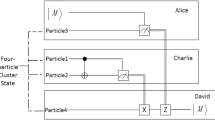Abstract
Motivated by proxy signature and blind signature for the secure communications, the batch signature is proposed to create a novel quantum cryptosystem. It is based on three-dimensional two-particle-entangled quantum system which is used to distribute the quantum keys and create strings of quantum-trits (qutrits) for messages. All of the messages, which are expected to be signed, are encrypted by the private key of the message owner during communications. Different from the classical blind signature, an authenticity verification of signatures and an arbitrator’s efficient batch proxy signature are simultaneously applied in the present scheme. Analysis of security and efficiency shows that it enables us to achieve a large number of quantum blind signatures for quantities of messages with a high efficiency with the arbitrator’s secure batch proxy blind signature.
Similar content being viewed by others
References
William S. Cryptography and Network Security: Principles and Practice. 2nd ed. New Jersey: Prentice Hall, 2003. 67–68
Cao Z J, Liu M L. Classification of signature-only signature models. Sci China Ser F-Inf Sci, 2008, 51: 1083–1095
Lu R X, Dong X L, Cao Z F. Designing efficient proxy signature schemes for mobile communication. Sci China Ser F-Inf Sci, 2008, 51: 183–195
Schneier B. Applied Cryptography: Protocols, Algorithms, and Source Code in C. 2nd ed. New York: John Wiley and Sons, 1996. 79–80
Chaum D, Heyst E V. Group signatures, advances in cryptography-EUROCRYPT’91. Lect Notes Comput Sci, 1991, 547: 257–265
Fan C I, Lei C L. Efficient blind signature scheme based on quadratic residues. Electron Lett, 1996, 32: 811–813
Zeng G H, Ma W P, Wang X M, et al. Signature scheme based on quantum cryptography (in Chinese). Acta Electron Sin, 2001, 29: 1098–1100
Zeng G H, Keitel C H. Arbitrated quantum-signature scheme. Phys Rev A, 2002, 65: 1–6
Curty M, Lütkenhaus N. Comment on “Arbitrated quantum-signature scheme”. Phys Rev A, 2008, 77: 1–4
Zeng G H. Reply to “Comment on ‘Arbitrated quantum-signature scheme’”. Phys Rev A, 2008, 78: 1–5
Li Q, Chan W H, Long D Y. Arbitrated quantum signature scheme using Bell states. Phys Rev A, 2009, 79: 1–4
Gottesman D, Chuang L I. Quantum digital signatures. arXiv:quant-ph/0105032v2, 2001
Lee H, Hong C, Kim H, et al. Arbitrated quantum signature scheme with message recovery. Phys Lett A, 2004, 321: 295–300
Shi J J, Shi R H, Tang Y, et al. A multiparty quantum proxy group signature scheme for the entangled-state message with quantum Fourier transform. Quantum Inf Process, 2011, doi: 10.1007/s11128-010-0225-7
Wen X J, Niu X M, Ji L P, et al. A weak blind signature scheme based on quantum cryptography. Optics Commun, 2009, 282: 666–669
Meijer H, Akl S. Digital signature schemes. Advance in Cryptography, Proceedings of Crypto’81. Berlin: Springer-Verlag, 1981. 65–76
Nielsen M A, Chuang I L. Quantum Computation and Quantum Information. Cambridge: Cambridge University Press, 2000. 171–607
He G Q, Zhu J, Zeng G H. Quantum secure communication using continuous variable Einstein-Podolsky-Rosen correlations. Phys Rev A, 2006, 73: 1–7
Bennett C H, Bessette F, Brassard G, et al. Experimental quantum cryptography. J Cryptology, 1992, 5: 3–28
Buttler W T, Hughes R J, Kwiat P G, et al. Free-space quantum-key distribution. Phys Rev A, 1998, 57: 2379–2382
Shor P W, Preskill J. Simple proof of security of the BB84 quantum key distribution protocol. Phys Rev Lett, 2000, 85: 441–444
Oliveira D S, Ramos R V. Quantum bit string comparator: circuits and applications. Quantum Comput Comput, 2007, 7: 17–26
Guo Y, Zeng G H, Chen Z G. Multiparty quantum secret sharing of quantum states with quantum registers. Chin Phys Lett, 2007, 24: 863–866
Li F G, Shirase M, Takagi T. Cryptanalysis of efficient proxy signature schemes for mobile communication. Sci China Inf Sci, 2010, 53: 2016–2021
Author information
Authors and Affiliations
Corresponding author
Rights and permissions
About this article
Cite this article
Shi, J., Shi, R., Guo, Y. et al. Batch proxy quantum blind signature scheme. Sci. China Inf. Sci. 56, 1–9 (2013). https://doi.org/10.1007/s11432-011-4422-5
Received:
Accepted:
Published:
Issue Date:
DOI: https://doi.org/10.1007/s11432-011-4422-5




